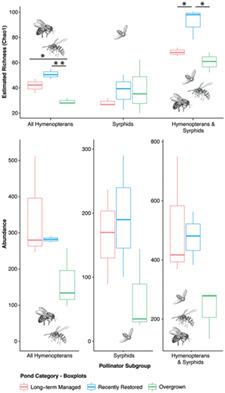当前位置:
X-MOL 学术
›
Insect Conserv. Divers.
›
论文详情
Our official English website, www.x-mol.net, welcomes your feedback! (Note: you will need to create a separate account there.)
Open‐canopy ponds benefit diurnal pollinator communities in an agricultural landscape: implications for farmland pond management
Insect Conservation and Diversity ( IF 3.5 ) Pub Date : 2020-09-24 , DOI: 10.1111/icad.12452 R.E. Walton 1 , C.D. Sayer 1 , H. Bennion 1 , J.C. Axmacher 1, 2
中文翻译:

开阔的池塘使农业景观中的每日授粉媒介社区受益:对农田池塘管理的影响
更新日期:2020-09-24
Insect Conservation and Diversity ( IF 3.5 ) Pub Date : 2020-09-24 , DOI: 10.1111/icad.12452 R.E. Walton 1 , C.D. Sayer 1 , H. Bennion 1 , J.C. Axmacher 1, 2
Affiliation

|
- Declines in pollinating invertebrates across intensively cultivated landscapes linked to reductions in flower‐rich habitats constitute a key threat to biodiversity conservation and the provision of ecosystem services. Over recent decades, many ponds in agricultural landscapes have become overgrown with woody vegetation, resulting in heavily shaded, flower‐poor pond basins and margins. Restoration of farmland ponds through removal of sediment and encroaching woody vegetation (canopy management) from pond margins greatly enhances freshwater biodiversity. Nevertheless, the consequences of pond management for pond‐margin plants and pollinating insects remain poorly understood. Here, we studied these effects for ponds in Norfolk, eastern England.
- We compared richness, abundance and composition of pollinating insects (hymenopterans and syrphids) and insect‐pollinated plant communities between open‐canopy pond systems subjected to either (i) long‐term regular management of woody vegetation or (ii) recent restoration by woody vegetation and sediment removal with those communities at (iii) ponds dominated by woody vegetation.
- Canopy management increased the richness and abundance of pollinators and insect‐pollinated plants. Pollinator richness and abundance was best explained by improvements in flower resources at open‐canopy ponds. Management most strongly influenced hymenopteran communities.
- Ponds represent important semi‐natural habitats for insect‐pollinated plant and pollinator communities in farmland. To enhance food resources, diversity and abundance of diurnal pollinators, conservation management at ponds should aim for mosaics of ponds at different successional stages with a high proportion of early successional open‐canopy ponds. Agricultural ponds are emerging as important habitats not only for aquatic biodiversity, but also for terrestrial species, thus warranting their prioritisation in future agri‐environment schemes.
中文翻译:

开阔的池塘使农业景观中的每日授粉媒介社区受益:对农田池塘管理的影响
- 集约化耕种景观中无脊椎动物的授粉量下降与富花生境的减少有关,这对生物多样性保护和提供生态系统服务构成了重大威胁。在最近的几十年中,农业景观中的许多池塘已经长满了木本植物,造成了阴影浓密,花朵贫乏的池塘盆地和边缘。通过清除沉积物和侵蚀池塘边缘的木本植物(冠层管理)来恢复农田池塘,大大增强了淡水生物多样性。然而,对池塘管理对池塘边缘植物和授粉昆虫的后果仍然知之甚少。在这里,我们研究了英格兰东部诺福克郡池塘的这些影响。
- 我们比较了(i)长期定期管理木本植被或(ii)最近通过木本植被恢复的开放式林冠水塘系统之间的授粉昆虫(膜翅目和Syrphids)和昆虫授粉植物群落的丰富度,丰度和组成。 (iii)以木本植被为主的池塘中的那些社区的泥沙清除。
- 冠层管理增加了授粉媒介和昆虫授粉植物的丰富度和丰度。可以通过开放冠层池塘花卉资源的改善来最好地解释授粉媒介的丰富度和丰度。管理对膜翅目群落的影响最大。
- 池塘是农田中昆虫授粉植物和授粉媒介群落的重要半自然栖息地。为了增加食物资源,昼夜授粉媒介的多样性和丰富性,池塘的养护管理应针对不同演替阶段的池塘马赛克,其中包括早期演替开放式高比例池塘。农业池塘不仅是水生生物多样性的重要栖息地,而且是陆生物种的重要生境,因此有必要在未来的农业环境计划中优先考虑。


























 京公网安备 11010802027423号
京公网安备 11010802027423号